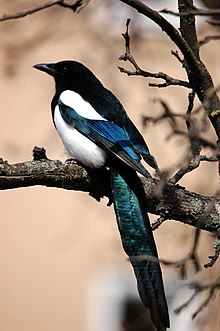Pica is a genus of seven species of birds in the family Corvidae in both the New World and the Old. It is one of several corvid genera whose members are known as magpies.
| Pica Temporal range:
| |
|---|---|

| |
| Eurasian magpie (P. pica) | |
| Scientific classification | |
| Domain: | Eukaryota |
| Kingdom: | Animalia |
| Phylum: | Chordata |
| Class: | Aves |
| Order: | Passeriformes |
| Family: | Corvidae |
| Genus: | Pica Brisson, 1760 |
| Type species | |
| Corvus pica Linnaeus, 1758
| |
| Species | |
Pica have long tails and have predominantly black and white markings. For instance, one species travels throughout Europe to Asia, one lives in western North America, one stays within California, one is confined to southwestern Saudi Arabia, and another one comes from North Africa. The last two species are often considered subspecies of the Eurasian. They were previously considered closely related to the blue and green magpies of Asia, but research suggests their closest relatives are the Eurasian crows.[1]
Taxonomy
editThe genus Pica was introduced by the French zoologist Mathurin Jacques Brisson in 1760.[2][3] He derived the name by tautonymy from the specific epithet of the Eurasian magpie Corvus pica which was introduced by Linnaeus in 1758.[3][4] Pica is the Latin word for the Eurasian magpie.[5]
In 2018, a molecular phylogenetic study found that the Eurasian magpie consisted of multiple species including the Maghreb magpie, the Asir magpie, the black-rumped magpie and the oriental magpie.[6]
Species
editThe genus contains seven living species:[7]
| Common name | Scientific name and subspecies | Range | Size and ecology | IUCN status and estimated population |
|---|---|---|---|---|
| Eurasian magpie | Pica pica (Linnaeus, 1758) Six subspecies
|
Europe and Asia |
Size: Habitat: Diet: |
LC
|
| Maghreb magpie | Pica mauritanica Malherbe, 1845 |
northwest Africa |
Size: Habitat: Diet: |
LC
|
| Asir magpie | Pica asirensis Bates, 1936 |
Asir Region of Saudi Arabia |
Size: Habitat: Diet: |
EN
|
| Black-rumped magpie | Pica bottanensis (Delessert, 1840) |
central Bhutan, west-central China | Size: Habitat: Diet: |
LC
|
| Oriental magpie | Pica serica Gould, 1845 |
southeastern Russia and Myanmar to eastern China, Korea, Japan, Taiwan and northern Indochina | Size: Habitat: Diet: |
LC
|
| Black-billed magpie | Pica hudsonia (Sabine, 1823) |
western half of North America |
Size: Habitat: Diet: |
LC
|
| Yellow-billed magpie | Pica nuttalli (Audubon, 1837) |
California |
Size: Habitat: Diet: |
LC
|
Fossil species
editTwo prehistoric species of Pica are currently known: Pica mourerae, from fossils found in Pliocene–Pleistocene boundary strata on Mallorca, and Pica praepica, from Early Pleistocene strata of Bulgaria.[8][9]
References
edit- ^ Ericson, Per G. P.; Jansén, Anna-Lee; Johansson, Ulf S.; Ekman, Jan (2005). "Inter-generic relationships of the crows, jays, magpies and allied groups (Aves: Corvidae) based on nucleotide sequence data" (PDF). Journal of Avian Biology. 36 (3): 222–234. doi:10.1111/j.0908-8857.2001.03409.x.
- ^ Brisson, Mathurin Jacques (1760). Ornithologie, ou, Méthode contenant la division des oiseaux en ordres, sections, genres, especes & leurs variétés (in French and Latin). Vol. 1. Paris: Jean-Baptiste Bauche. p. 30.
- ^ a b Mayr, Ernst; Greenway, James C. Jr, eds. (1962). Check-list of Birds of the World. Vol. 15. Cambridge, Massachusetts: Museum of Comparative Zoology. p. 250.
- ^ Linnaeus, C. (1758). Systema Naturæ per regna tria naturae, secundum classes, ordines, genera, species, cum characteribus, differentiis, synonymis, locis, Volume 1 (in Latin). Vol. 1 (10th ed.). Holmiae:Laurentii Salvii. p. 106.
- ^ Jobling, James A (2010). The Helm Dictionary of Scientific Bird Names. London: Christopher Helm. p. 305. ISBN 978-1-4081-2501-4.
- ^ Song, S.; Zhang, R.; Alström, P.; Irestedt, M.; Cai, T.; Qu, Y.; Ericson, P.G.P.; Fjeldså, J.; Lei, F. (2017). "Complete taxon sampling of the avian genus Pica (magpies) reveals ancient relictual populations and synchronous Late-Pleistocene demographic expansion across the Northern Hemisphere". Journal of Avian Biology. 49 (2): jav–01612. doi:10.1111/jav.01612.
- ^ Gill, Frank; Donsker, David; Rasmussen, Pamela, eds. (January 2021). "Crows, mudnesters, birds-of-paradise". IOC World Bird List Version 11.1. International Ornithologists' Union. Retrieved 28 June 2021.
- ^ Seguí, B. (2001). "A new species of Pica (Aves: Corvidae) from the Plio-Pleistocene of Mallorca, Balearic Islands (Western Mediterranean)". Geobios. 34 (3): 339–347. Bibcode:2001Geobi..34..339S. doi:10.1016/s0016-6995(01)80080-2. ISSN 0016-6995.
- ^ Boev, Zlatozar (2021-06-01). "An Early Pleistocene magpie (Pica praepica sp. n.) (Corvidae Leach, 1820) from Bulgaria". Bulletin of the Natural History Museum - Plovdiv. 6: 51–59.